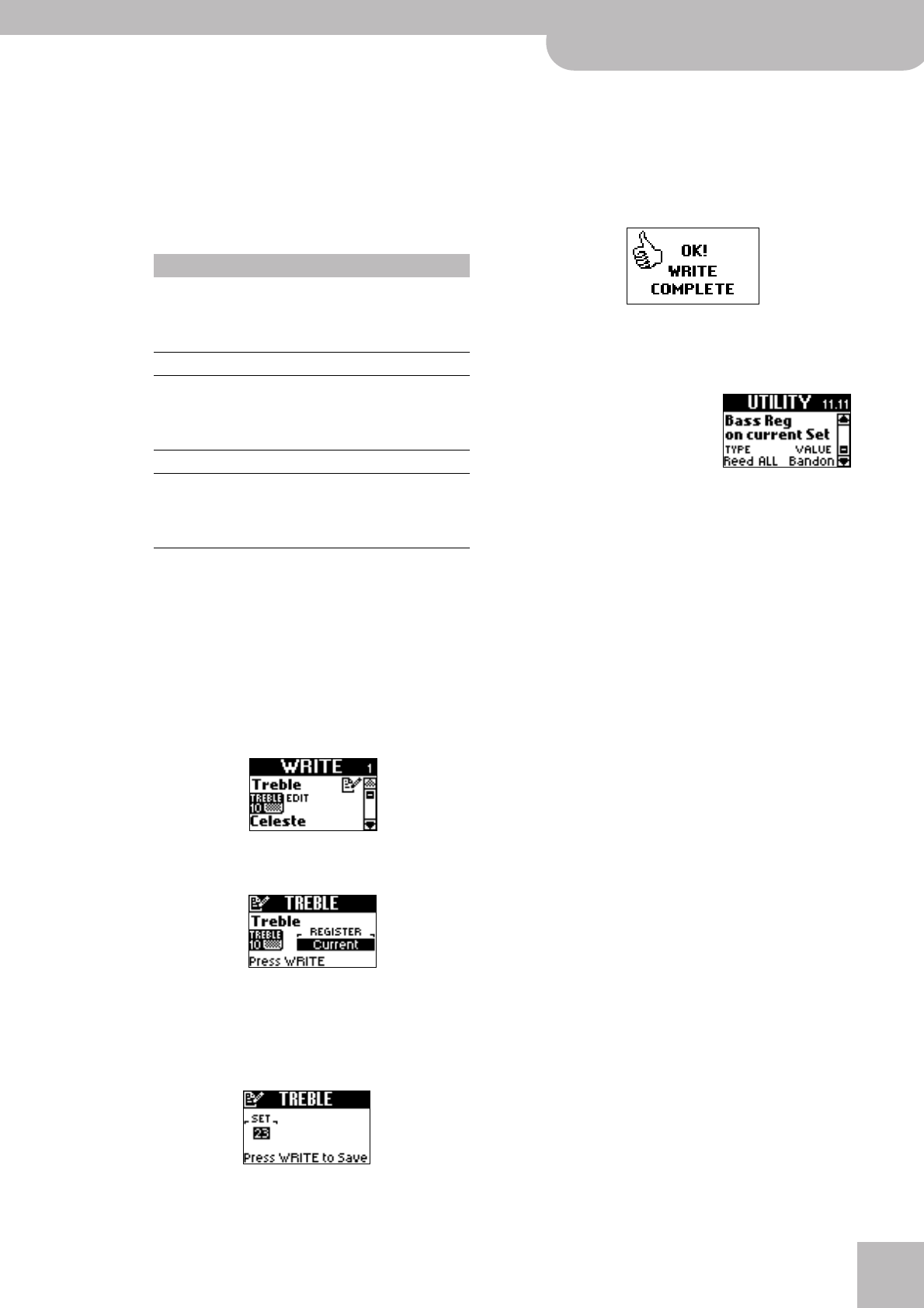
11.11 Bass Reg. on current Set
V-Accordion
r
79
Note: The “Vol” values you set here directly affect the volume
parameters of the respective edit modes. In other words:
selecting “5” here means that the corresponding reeds’ volume
is set to “5”.
(4) Press the [DATA÷ENTER] knob to select “VALUE”,
then rotate the [DATA÷ENTER] knob to select the
desired setting.
The possibilities depend on the choice you made in
step (3) above.
Note: Reeds that are currently off (see “2.2 Register” on p. 46)
adopt the new setting but are not switched on by this opera-
tion.
(5) Press [EXIT÷JUMP] to return to the Main page and
try out all 14 Treble registers.
Note: Do not change Sets at this stage, because that would
erase the changes you have just made.
(6) If you like your new settings, save them:
• Press and hold the [MENU÷WRITE] button until the
following page appears:
• Press the [DATA÷ENTER] knob to confirm your selec-
tion.
• Use the [DATA÷ENTER] knob or the [UP]/[DOWN] but-
tons to select “ALL”.
• Press the [DATA÷ENTER] knob to confirm your selec-
tion.
The display now looks as follows:
• Use the [DATA÷ENTER] knob or the [UP]/[DOWN] but-
tons to select the Set that should contain your
changed version(s).
Change this setting only if you do not want to save
your settings to the current Set.
• Press the [MENU÷WRITE] button to save your
changes. The display briefly shows a confirmation:
• Press the [EXIT÷JUMP] button to return to the Main
page.
11.11 Bass Reg. on current Set
This is an environment in its
own right rather than a param-
eter. It allows you to set six
parameters for all Bass registers
of the currently selected Set
simultaneously. This may help you save a lot of time,
especially for increasing or decreasing the volume of
some or all reeds, or for selecting a different noise type.
But be careful not to overuse this functionality.
Here’s how to take advantage of this environment:
(1) Select the Set whose Bass registers you want to
edit simultaneously.
(2) Select this parameter (“11.11 Bass Reg. on
current Set”).
See p. 39 for the two possible approaches (one via
the JUMP menu, the other using the registers).
(3) Turn the [DATA÷ENTER] knob to select the parame-
ter to be edited for all Bass registers.
The possibilities are:
Reed: Reed ALL, Reed 16’, Reed 8’, Reed 8’-4’, Reed 4',
Reed 2’
Volume: Vol ALL, Vol 16’, Vol 8’, Vol 8'-4’, Vol 4’, Vol 2’
Others: Noise, Noise Vol, Reed Growl, Growl Vol
As you see, this step may involve two actions:
(a) You first need to decide which parameter type
you want to edit (“Reed”, “Vol”, “Noise”, “Noise Vol”,
“Reed Growl”, or “Growl Vol”);
(b) Select the reeds your change should apply to (only
for “Reed” and “Vol”).
Here’s an example: to set the reed type of all 16’
reeds (one per register) of the current Set to
“Organetto”, turn the [DATA÷ENTER] knob until “Reed
16’” is displayed, then proceed with the next step.
See also “Meaning of the warning that may appear”
on p. 78.
(4) Press the [DATA÷ENTER] knob to select “VALUE”,
then rotate the [DATA÷ENTER] knob to select the
desired setting.
Parameter Setting range
Reed Bandoneon, I-Folk, I-Folk2, Classic, Cajun,
Jazz, F-Folk, D-Folk, Organetto, F-Folk2,
Classic2, Studio, Tradition, Steierische,
OldItaly, TexMex, Trikitixa
Vol Off, –40~Std~40
Noise
Bandoneon, I-Folk, I-Folk2, Classic, Cajun,
Jazz, F-Folk, D-Folk, Organetto, F-Folk2,
Classic2, Studio, Tradition, Steierische,
OldItaly, TexMex, Trikitixa
Noise Vol Off, –40~Std~40
Detune
Off, Dry, Classic, F-Folk, American_L,
American_H, North_Eur, German_L,
D-Folk_L, Italian_L, German_H, Alpine,
Italian_H, D-Folk_H, French, Scottish


















